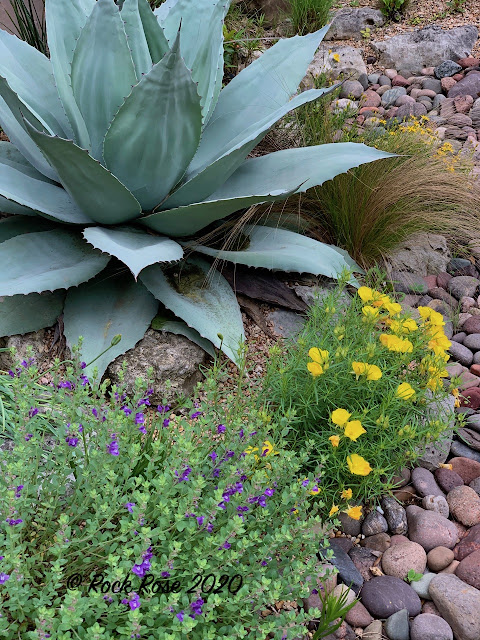The wall creates a raised bed which follows the curved wall which encloses the garden. This was really necessary if I wanted to grow anything.
I love to capture the sun just as it peaks through the archway in the morning.
It lights up the Mexican feather grasses.
Not all English gardens are cottage gardens with lawns. In England there are many gravel gardens and gardens planted in the Mediterranean style, and although I didn't imagine this at the time, it is the way the garden developed and it made sense to eliminate lawns completely. It would have been so much work getting a lawnmower in here and so much more water to keep it looking good. Instead I decided on gravel and I am really happy with the way it looks most of the time.
In my usual style a majority of the plants growing in the gravel have self-seeded and although it is work to keep it under control when it is at its best it looks great.
I confess I did plant the silver leaf gazania last year and it survived the winter.
A few days ago the gazania was looking wonderful and then with the heat yesterday and today it just started to wilt. Maybe the underlying soil was just too wet from all the rain we have had this spring.
One of my favorite flowers which have had wonderful success are the skullcaps-particularly the native Wright's skullcap, Scutellaria wrightii. It is one of the few plants that will last all through the year and with an early spring trim will stay in a mounding shape. When I prune off old growth I walk around sprinkling the seed into other areas. That and the Blackfoot daisy, Melampodium leucanthum, require no irrigation.
An English garden should have roses and yes there are a few of these but I could be doing so much better. I originally planted 3 knockout roses around the birdbath in memory of my mother and a friend who died of breast cancer. Then added 3 white ones in between. Unfortunately one of the red ones died and I have been planning to replace it for several years. Yes, with just another knockout rose but quite honestly they are fuss free-so far. No bugs, no blackspot and as long as they don't get rose rosette disease they will stay. And if that happens I will switch to salvias.
But my other roses are not doing so well. So far this year Felicia has had blackspot and thrips but still still she has managed to provide me with wonderful fragrance when I have been working outside.
My idea was to replicate the pillar roses I had seen at Mottisfont, but then I am afraid I don't have their expertise. It's not too late to give them a big trim back because Felicia is a reliable repeat bloomer through the season.
But my big failure has been in that raised bed I created. I never put any thought into the planting and just put plants in there willy nilly. Mostly passalongs. The shasta daisies have almost taken over one section and the pale pavonias are crowding out other plants with their scrappy stems reaching for the sun. One side gets more sun than the other and the vines on the wall have moved into the beds. It is my plan to overhaul the whole bed or in the very least move some plants out of there. But that has been in the plan for a few years so we will see how far I get this year.














































